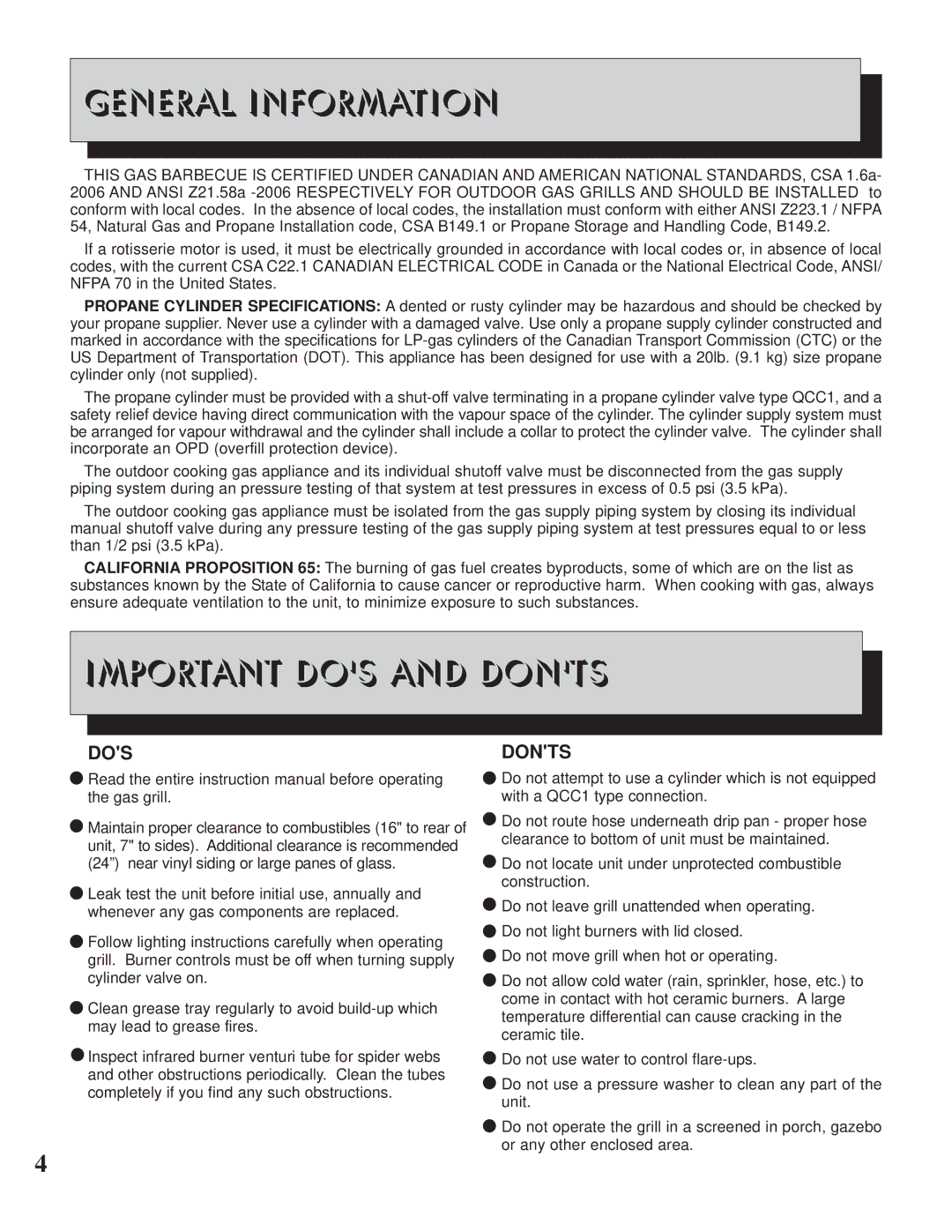
GENERAL INFORMATION
THIS GAS BARBECUE IS CERTIFIED UNDER CANADIAN AND AMERICAN NATIONAL STANDARDS, CSA 1.6a- 2006 AND ANSI Z21.58a
If a rotisserie motor is used, it must be electrically grounded in accordance with local codes or, in absence of local codes, with the current CSA C22.1 CANADIAN ELECTRICAL CODE in Canada or the National Electrical Code, ANSI/ NFPA 70 in the United States.
PROPANE CYLINDER SPECIFICATIONS: A dented or rusty cylinder may be hazardous and should be checked by your propane supplier. Never use a cylinder with a damaged valve. Use only a propane supply cylinder constructed and marked in accordance with the specifications for
The propane cylinder must be provided with a
The outdoor cooking gas appliance and its individual shutoff valve must be disconnected from the gas supply piping system during an pressure testing of that system at test pressures in excess of 0.5 psi (3.5 kPa).
The outdoor cooking gas appliance must be isolated from the gas supply piping system by closing its individual manual shutoff valve during any pressure testing of the gas supply piping system at test pressures equal to or less than 1/2 psi (3.5 kPa).
CALIFORNIA PROPOSITION 65: The burning of gas fuel creates byproducts, some of which are on the list as substances known by the State of California to cause cancer or reproductive harm. When cooking with gas, always ensure adequate ventilation to the unit, to minimize exposure to such substances.
IMPORTANT DO'S AND DON'TS
DO'S | DON'TS |
![]() Read the entire instruction manual before operating the gas grill.
Read the entire instruction manual before operating the gas grill.
![]() Maintain proper clearance to combustibles (16" to rear of unit, 7" to sides). Additional clearance is recommended (24”) near vinyl siding or large panes of glass.
Maintain proper clearance to combustibles (16" to rear of unit, 7" to sides). Additional clearance is recommended (24”) near vinyl siding or large panes of glass.
![]() Leak test the unit before initial use, annually and whenever any gas components are replaced.
Leak test the unit before initial use, annually and whenever any gas components are replaced.
![]() Follow lighting instructions carefully when operating grill. Burner controls must be off when turning supply cylinder valve on.
Follow lighting instructions carefully when operating grill. Burner controls must be off when turning supply cylinder valve on.
![]() Clean grease tray regularly to avoid
Clean grease tray regularly to avoid
![]() Inspect infrared burner venturi tube for spider webs and other obstructions periodically. Clean the tubes completely if you find any such obstructions.
Inspect infrared burner venturi tube for spider webs and other obstructions periodically. Clean the tubes completely if you find any such obstructions.
4
![]() Do not attempt to use a cylinder which is not equipped with a QCC1 type connection.
Do not attempt to use a cylinder which is not equipped with a QCC1 type connection.
![]() Do not route hose underneath drip pan - proper hose clearance to bottom of unit must be maintained.
Do not route hose underneath drip pan - proper hose clearance to bottom of unit must be maintained.
![]() Do not locate unit under unprotected combustible construction.
Do not locate unit under unprotected combustible construction.
![]() Do not leave grill unattended when operating.
Do not leave grill unattended when operating.
![]() Do not light burners with lid closed.
Do not light burners with lid closed.
![]() Do not move grill when hot or operating.
Do not move grill when hot or operating.
![]() Do not allow cold water (rain, sprinkler, hose, etc.) to come in contact with hot ceramic burners. A large temperature differential can cause cracking in the ceramic tile.
Do not allow cold water (rain, sprinkler, hose, etc.) to come in contact with hot ceramic burners. A large temperature differential can cause cracking in the ceramic tile.
![]() Do not use water to control
Do not use water to control
![]() Do not use a pressure washer to clean any part of the unit.
Do not use a pressure washer to clean any part of the unit.
![]() Do not operate the grill in a screened in porch, gazebo or any other enclosed area.
Do not operate the grill in a screened in porch, gazebo or any other enclosed area.
